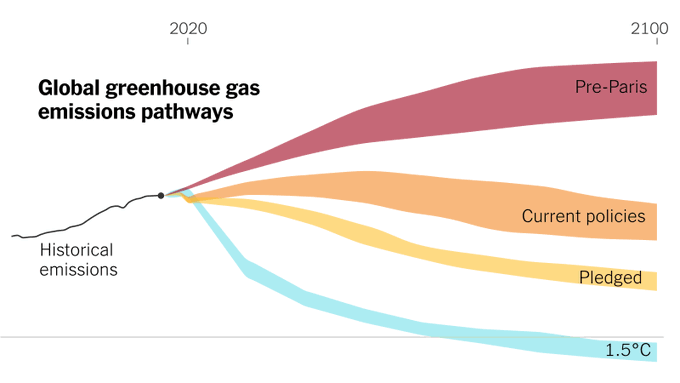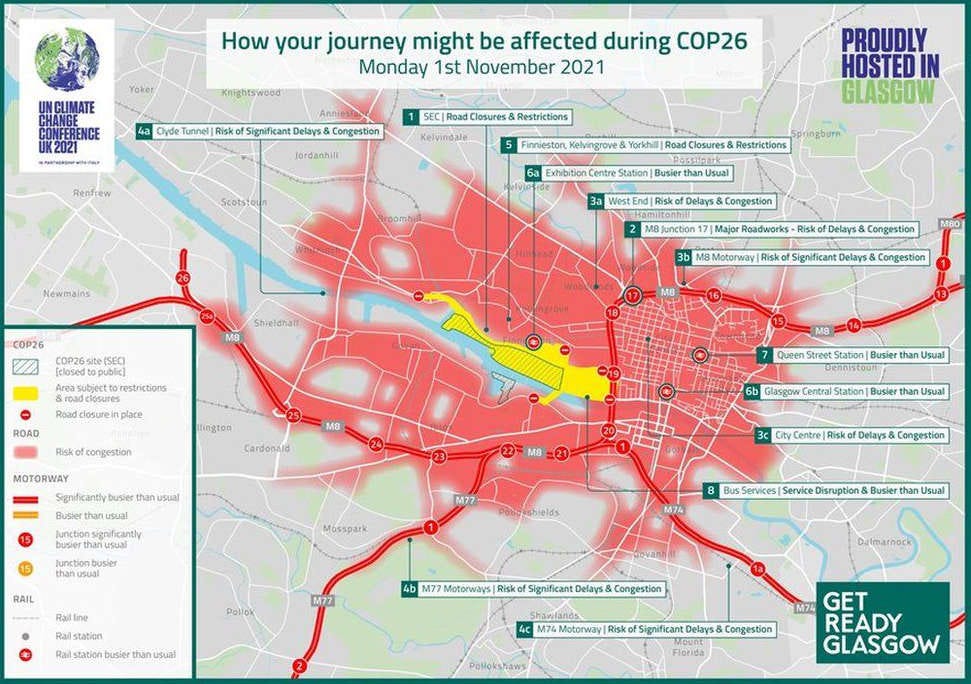The Great Pause Week 85: A COP Half Empty
"There needs to be rigorous belt-tightening, which many, likely most, will find unpleasant."
It never fails to amaze me how short the collective human memory is from one climate summit to the next. In the weeks and months preceding, there is a flurry among government departments unhappily tasked with making newsworthy commitments in incredibly short time frames; a rash of hyper-urgent warning documents issuing from scientific bodies; activists converging on the venue at great risk, expense and large greenhouse footprint to call for general strikes and boycotts, march, and non-violently obstruct already hamstrung transit systems; and media reporters treating the entire enterprise as if they just fell off a turnip truck and don’t really get the whole concept, but whatever it is, they have heard that it doesn’t work, and never will, so that will be the main story. “Just blah, blah, blah,” to quote Greta Thunberg, who will be there to carry signs that say as much with her youthful entourage.
Don’t get me wrong. Every step, every strategy, every effort is needed and helpful in its own way. Yesterday there were meetings of the African Group and the Small Island Developing States. Today there are the 6th Meeting of the Facilitative Working Group (FWG) of the Local Communities and Indigenous Peoples Platform (LCIPP) and the 5th Meeting of the Katowice Committee of Experts on the Impacts of the Implementation of Response Measures (KCI). Tomorrow there is a pre-COP caucus of the G-77 and China.
Just to be clear, having written the Christmas 2015 bestseller, The Paris Agreement (still in print at a bargain price), let me break it down for you. These meetings are existentially important but “forged on contradiction.”
Every signatory agreed that everyone must do something to address the urgent threat of climate change, but no one at the time pledged to do enough. In the years since the agreement, the emissions that trap heat in Earth’s atmosphere have continued to rise.
The nearly 200 countries who signed the Paris Agreement knew they had set a nearly impossible goal, at least from the standpoint of behavior demonstrated during the multi-hundred-thousand-year history of upright apes with tools.Because it is daunting, the Paris Agreement tried to break it down into simpler terms. Rather than deal with abstractions like 350 ppm or 450 ppm, or Watts per square meter, the framers tasked us with limiting global warming this century to less than a 2 degree (Celsius) rise above normal, with a more optimistic target of 1.5°C if it can be done (it can’t).
To hold to 2 degrees will require a radical shift away from fossil fuels. The problem: all those parts of civilization that fossils supply scaffolding for — heating and lighting, steel, cement, container shipping, air travel, BitCoin mining — cannot be reorganized from available renewables, at least not completely. There needs to be rigorous belt-tightening to close the gap, which many, likely most, will find unpleasant. That is the part that runs counter to our psychohistory and the Church of Limitless Growth (CLG).
A 2-degree target amounts to an annual 11 percent decline in energy use, halving each decade until we get to zero. It is a very strict diet, like intermittent fasting. For 1.5-degrees, the decline would be even steeper. Contrast that with the upslope of fossil’s build-out — adding 1 or 2 percent per year more creature comfort over the course of two centuries. Eleven is referred to as the Seneca cliff. It is less of a glide path — more of a dive bomb dive, with a pull-out well below the sea surface. Splash!
 |
| The New York Times |
Signatories were smart enough to leave themselves an escape hatch so they could sign the treaty in 2015, to much fanfare and applause — cue the fireworks display over the Eiffel Tower — without having to shock their parliaments, city planners or stock markets immediately. They put in a 5-year “stocktake” clause. Nothing much needed to happen before 2020.
Covid rejiggered the timing for COP26 Glasgow. It postponed the stocktake to November 2021, leaving just four years remaining for a 2025 course correction. The conference getting underway is for each nation to compare its actual accomplishments and pledge to make up the difference by 2025, when the targets will be adjusted downward once again at COP30.
Glasgow has closed its city to its own residents, businesses, and the usual tourists in preparation to receive 150 or more Heads of State including two, possibly more, US presidents; the royal family (sans the Queen who will come in by Skype); 190 national delegations each with up to 100 staffers and VIPs; 10,000 credentialed media requiring a million square feet of desk, video and radio production space, including scores of editing studios, stages, and satellite farms; and a Green Zone half as large as the giant industrial park Blue Zone, separated by a river, to keep busy tens of thousands of pre-certified NGOs, labor unionists, civil servants, tech companies, bankers, youth, tribes, educators and scientists with circuses of side events. The general public without tickets will be kept behind secure barriers manned by regiments of regular army, UN security, various secret services, and special forces, overflown by drones and circled by PT boats.It should surprise no one that not a single country passed its 5-year fossil quartering test. Fewer than 10 percent of signatories have even shared the news of the quartering requirement with the general populations of their countries. Arithmetic is apparently not taught in journalism school.
The Paris formula requires that every 5 years, each country set more ambitious targets for themselves based on individual pain thresholds, and eventually all converge collectively to achieve the 2-degree goal, halving emissions each decade. It is assumed that overdeveloped nations have lower pain thresholds and thus will proceed more slowly than underdeveloping nations who will be nimble and revert to pre-fossil lifestyles more quickly, having less distance to travel. Dmitry Orlov suggests we compare falling out of a fifth story window to exiting a window on the ground floor. In UN-parlance it is called common but differentiated responsibility. Ethopia is setting an example by skipping fossil fuels entirely and going straight to renewables. In UN-parlance this is called “leapfrogging” — the Ethiopian frog never left the sidewalk.
On October 11, the ministers of the 46 Most Underdeveloping Countries held a meeting in New York and asked the UN’s top climate change official, Patricia Espinosa, if she could come and share with them what she saw as the key issues to be decided in Glasgow.NOTE: We use the phrase “underdeveloping” quite intentionally because it has been our observation that the direction of transformation for much of the world is away from traditional means of providing for the needs of people, which were based on renewable resources and minimal rates of extraction for the non-renewables, towards unsustainable consumerist economies willing to sell their culture, patrimony, rights and finite natural resources for a shot at the Western lifestyle as might be portrayed in reruns of the TV soap, Dallas. We also use the term “overdeveloped” to describe industrialized economies that by any measure overspend for the sake of one species and one globalized culture an amount of non-renewable natural resources that is not possible to sustain for more than a short period of time, using the temporary abundance and net energy punch of fossil fuels. We prefer these terms to “developing,” “lesser-developed,” “developed,” “First World,” or “Third World,” because they indicate more accurately what is really happening. The overdeveloped need to scale back, radically. The underdeveloping need to quit trying to emulate Sweden or Denmark and rediscover their own roots and local economies.
— Bates, The Paris Agreement, page 26
Secretary Espinosa started off acknowledging what everyone in the room had noticed — the lack of progress, lack of ambition, and heel-dragging. As everyone there knew, her majesty the Queen of England and other members of the royal family had already taken their frustrations to the host, Boris Johnson, who, in his previous incarnation as a right wing newspaper columnist, was skeptical of the science of climate change and had ridiculed wind power as “too feeble to knock the skin off a rice pudding.” His government’s pledges to wean UK off fossil fuels by 2050 had not slowed new oil and gas production in the North Sea, or the subsidized production of nuclear, coal and peat. England was eyeing the possibly of a new coal plant in Cumbria and continuing airport expansions over the protests of civil engineers. As for tapping Scotland’s vast wind or tidal resources — fugeddaboutit.
To his credit, President Biden announced in April that the US would slash emissions within the decade by 50 to 52 percent. While still behind schedule, that’s a big step up from the Obama era target of 26 to 28 percent reductions by 2025 (which didn’t happen).
Espinosa said the IPCC’s report in August 2021 should have been the fire alarm. It was followed by the NDC Synthesis Report, an assessment of all national climate action plans, showing that even with all the national pledges of net zero now being offered by various dates, temperatures would still rise 2.7°C, or more, setting off a cascade of self-reinforcing feedbacks that might be impossible to reverse. While not voicing the worst in so many words, Espinosa painted a clear picture — we are crossing over a fiery abyss and the Bridge of Kahzad-Dûm is crumbling below our feet while the Balrog nips at our heels.
UN General Secretary António Guterres and Alok Sharma, the UK cabinet minister who will preside over the talks, have been shuttling around trying to get pre-agreement on key parts of the coming negotiations. Sharma warned that unless fast course correction was undertaken, “we will step through a series of one-way doors, the end destination of which is climate catastrophe.”
What were those key parts we need to agree to, the 46 MUC ministers wanted to know. The first priority was Paris’s Article 6, Espinosa said. The Article is too long to print here (but can be found in its entirety as an appendix to The Paris Agreement, available free to Kindle Unlimited subscribers).
Perhaps the key sentence in Article 6 is this one:
(4) A mechanism to contribute to the mitigation of greenhouse gases and support sustainable development is hereby established….
The Article then goes on to list the responsibilities of this “mechanism:”
- Incentivize and facilitate participation in mitigation by public and private parties
- Establish an equitable and closely regulated emissions trading program
- Establish a “rule book” for enforcing the Agreement
A major priority of the COP will be paying for change, Espinosa said. More than a decade has passed since Hillary Clinton scotched the Copenhagen COP by bribing the BRICSA bloc with a promise of $100 billion in assistance per year for MUCs by 2020. No-one had raised a quarter of that amount in the interim and MUC countries were smelling a con. Ol’ King Coal Joe Manchin, Glitter Queen Krysten Sinema and 50 Republican MAGAdiots made sure the US delegation would show up empty-handed yet again. The “final” infrastructure bills contain only tax incentives for polluters to pollute less. Taxing multibillionaires to reassign their low-earth orbit joyride money to de-fossilizing Yemen was just not happening after Manchin said it would be too “divisive.” But then, even $100 billion isn’t nearly enough. A negotiator representing African countries told Reuters that climate finance needs to be scaled up to $1.3 trillion per year by 2030.
The tax would be levied on anyone with more than $1 billion in assets or more than $100 million in income for three consecutive years — which applies to about 700 people in the United States. Initially, the legislation would impose the capital gains tax — 23.8 percent — on the gain in value of billionaires’ tradable assets, based on the original price of those assets…. legislation was also drafted to allow billionaires to continue their philanthropy without any tax penalty for money given away.
— The New York Times October 27, 2021
 As Joe Manchin so perfectly exemplifies, the larger challenge COP delegates have to confront will be dealing with greed. An 11 percent annual decline will not cause gas and coal prices to fall. They will rise. Sharply. Most going to Glasgow understand what psychological effect that will have on producer countries. Drill, baby, drill.
As Joe Manchin so perfectly exemplifies, the larger challenge COP delegates have to confront will be dealing with greed. An 11 percent annual decline will not cause gas and coal prices to fall. They will rise. Sharply. Most going to Glasgow understand what psychological effect that will have on producer countries. Drill, baby, drill.100,000+ protesters are expected for the Global Day For Climate Justice next Thursday. 10,000 Scottish checker-caps will be arrayed around them in 13 divisions, including firearms officers, dog handlers, mounted cavalry, search teams and a waterborne unit. They will be backed up by Royal Marines, armor, and AWACs. This will not be January 6th, but just in case anyone needs to be rounded up later, thousands of new face-recognition-enabled surveillance cameras have been installed on street corners and biometric ID scans are now mandatory at all ports of entry.
The Rail Transport union said members who work for ScotRail and Caledonian Sleeper will strike during the summit. About 1000 drivers of the Stagecoach Group bus lines will also be out. No worries, a fleet of electric buses will provide a free shuttle service for delegates between the city centre hotels and the COP venues, including the first hydrogen double deckers and all the zero emission (electric/hydrogen) hybrid buses due to populate Ireland next Spring. Roads around the COP have been closed to all other traffic.
I don’t believe the protests or how they are repressed will have any real effect apart from on those who are gassed, jailed or infected with Delta-plus. Back in the Blue Zone national leaders will meet and talk amongst themselves. Deals will be struck. All the rest is circus. The burden has been and will continue to be on those national governments to do the right thing.
The confrontation — not between protesters and police but between delaying excuses and climate reality — will be what makes Glascow-2021 not just the largest event Scotland has ever hosted but the most important international conference in history. Buckle up.
You can join COP26 events live at the Glasgow Science Centre by applying for the free tickets or by joining online — Plenaries will be broadcast live and archived at UN web tv. Green Zone side events will be streamed and archived on the COP26 YouTube channel.
There will be more than 200 side events hosted, involving 300 organizations of young people, indigenous leaders, science and academic groups, businesses and grassroots networks. These sometimes include cultural performances, exhibitions, talks, film screenings and technical demonstrations to a global audience.
As the world confronts the pandemic and emerges into recovery, there is growing recognition that the recovery must be a pathway to a new carbon economy, one that goes beyond zero emissions and runs the industrial carbon cycle backwards — taking CO2 from the atmosphere and ocean, turning it into coal and oil, and burying it in the ground. The triple bottom line of this new economy is antifragility, regeneration, and resilience.
Help me get my blog posted every week. All Patreon donations and Blogger subscriptions are needed and welcomed. You are how we make this happen. Your contributions are being made to Global Village Institute, a tax-deductible 501(c)(3) charity. PowerUp! donors on Patreon get an autographed book off each first press run. Please help if you can.
#RestorationGeneration
“There are the good tipping points, the tipping points in public consciousness when it comes to addressing this crisis, and I think we are very close to that.”
— Climate Scientist Michael Mann, January 13, 2021.
Want to help make a difference while you shop in the Amazon app, at no extra cost to you? Simply follow the instructions below to select “Global Village Institute” as your charity and activate AmazonSmile in the app. They’ll donate a portion of your eligible purchases to us.
How it works:
1. Open the Amazon app on your phone
2. Select the main menu (=) & tap on “AmazonSmile” within Programs & Features
3. Select “Global Village Institute” as your charity
4. Follow the on-screen instructions to activate AmazonSmile in the mobile app







Comments
Strangely, there has been some kind of "Come-to-climate" awakening in the media. Guest who might be on Radio Ecoshock are showing up on ABC News or the cable networks. ABC promises a full 30 days of climate reporting, including broadcasting from Glasgow. They spent the last 20 years muzzling their weather reporters to never draw the lines to the cause.
It makes one wonder what happened at corporate ownership in the very small group of mass media boardrooms. Does somebody think their yachts or estates are at risk? What happened in 2021 that brings this last minute (actually way past last minute) conversion? I'm waiting for them to well and truly discover Albert Bates.